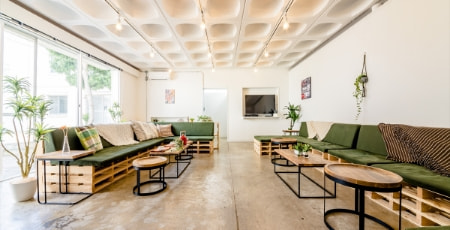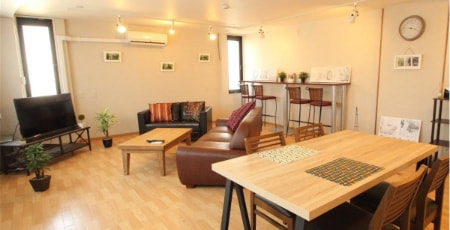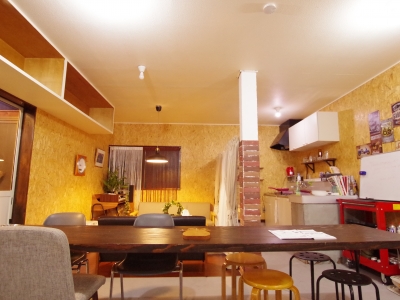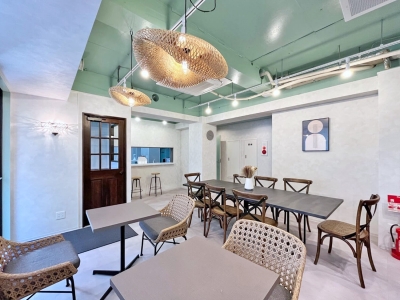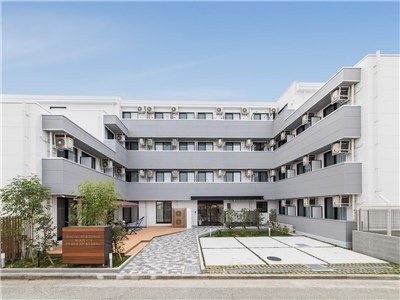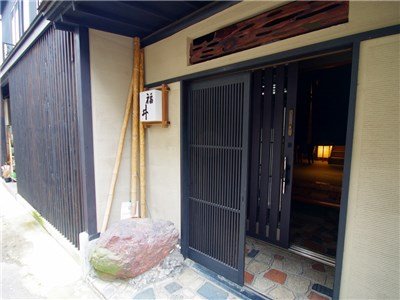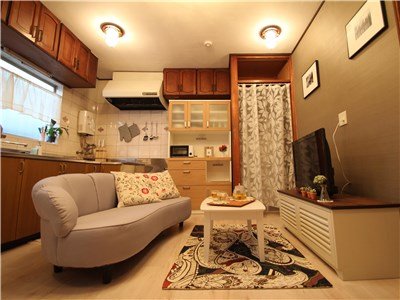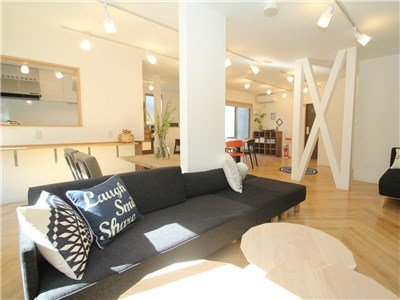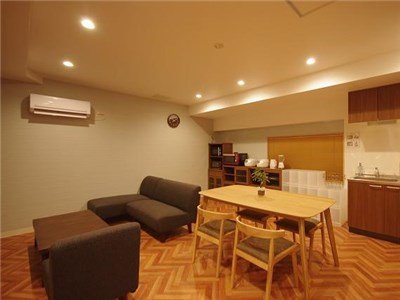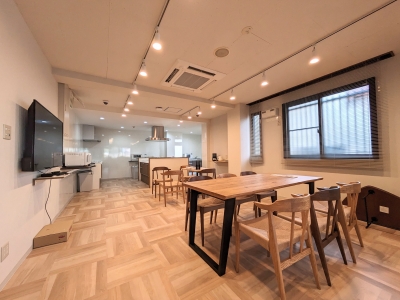- A Guesthouse with attractive “Low Cost” and “Communication”
- Accommodation space + Shared facilities
- Good accommodation cost
- How is Guesthouse different from a Sharehouse?
- How is Guesthouse different from Room Sharing?
- The Origin of the Guesthouse
- What kind of people are staying at a Guesthouse?
- Related article

What is Guesthouse?
A Guesthouse with attractive “Low Cost” and “Communication”
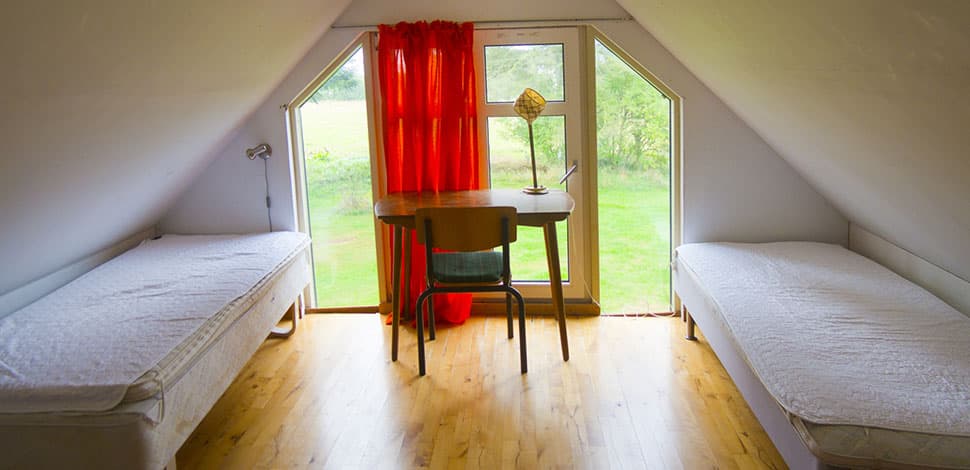 A Guesthouse is a form of accommodation that is sometimes being called the simple lodging or B&B (Bed and breakfast). Unlike hotels or traditional Japanese inns, the characteristic of a Guesthouse is to keep the service aspect to a minimum, as it contains dormitories (shared room), shared toilets and bathrooms, with no amenities provided, and set the accommodation cost at a low price.
A Guesthouse is a form of accommodation that is sometimes being called the simple lodging or B&B (Bed and breakfast). Unlike hotels or traditional Japanese inns, the characteristic of a Guesthouse is to keep the service aspect to a minimum, as it contains dormitories (shared room), shared toilets and bathrooms, with no amenities provided, and set the accommodation cost at a low price.
Foreign tourists are often using Guesthouse, mainly backpackers, and it is common for the tourists to gather in the shared living room and kitchen while communicating with one another. With the charm of communicating with people from around the world, more users tend to choose to stay at a Guesthouse rather than a hotel or traditional Japanese inn.
Accommodation space + Shared facilities
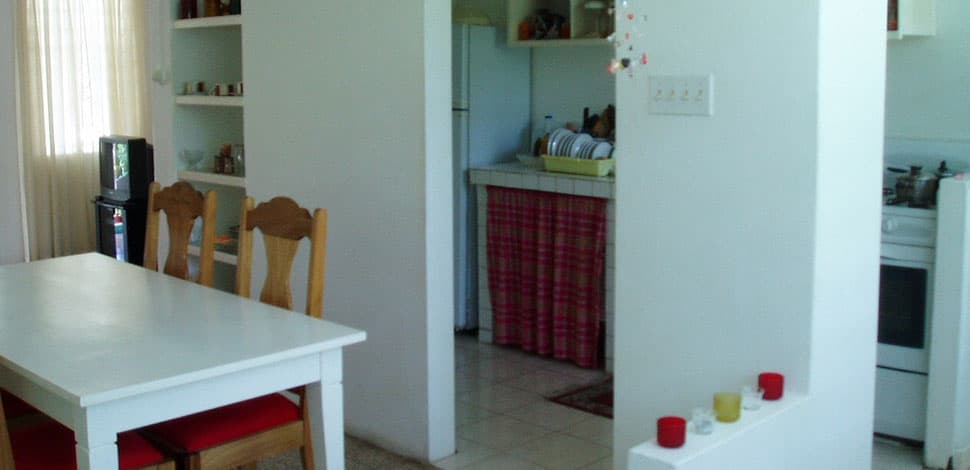 There are several different accommodation spaces, such as private rooms, dormitories (shared room), capsule types, and more. While for shared facilities, there is the kitchen, shower rooms (bathrooms), and toilets.
There are several different accommodation spaces, such as private rooms, dormitories (shared room), capsule types, and more. While for shared facilities, there is the kitchen, shower rooms (bathrooms), and toilets.
The Guesthouse accommodation space is prepared in various types depending on the house. Private rooms like those found in hotels or traditional Japanese inns, dormitories (shared rooms) with multiple people in one place, or capsule hotel style with multiple bed spaces in a large area are those examples. Lockers are also provided for the dormitories and capsule type rooms with locks for storing the valuables or luggage.
For the shared facilities, there is the living room, kitchen where people can feel free to use the cooking utensils, shower rooms (bathrooms), toilets, and washbasins. Some of the Guesthouses also contain coin laundry or vending machines and are specially designed to be comfortable for long-term guests.
Good accommodation cost
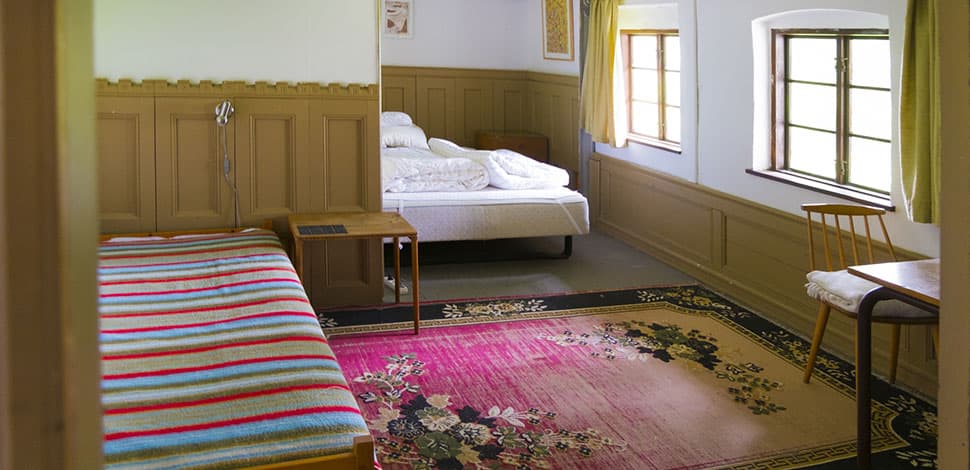 As hotels or traditional Japanese inns cost around JPY 10,000 per night, the Guesthouse provides a way lower costs around JPY 3,000 per night. Guesthouses can offer such low accommodation costs and it's because of limiting the service to the minimum. So, guests might have some kind of problems if they try to stay in the same way as they are in a hotel or traditional Japanese inn. The most significant difference is that Guesthouse has few assumptions to provide meals, while most hotels and traditional Japanese inns contain restaurants and serve breakfast and dinner most of the time. In particular, the traditional Japanese inns containing hot springs will usually provide meals to their customers and use it to attract more people. Many guests will also consider food as a significant factor when looking for accommodation. On the other hand, in the case of Guesthouse, they do not have any restaurants, and even if some serve simple snacks as breakfast services, no facility serves dinner. Instead, there is a shared kitchen, and the guests can purchase ingredients at a nearby supermarket and cook for themselves. With lots of foreigners, especially backpackers, at the Guesthouse, it also happens very often that the guests share their meals and start communication with one another using food.
As hotels or traditional Japanese inns cost around JPY 10,000 per night, the Guesthouse provides a way lower costs around JPY 3,000 per night. Guesthouses can offer such low accommodation costs and it's because of limiting the service to the minimum. So, guests might have some kind of problems if they try to stay in the same way as they are in a hotel or traditional Japanese inn. The most significant difference is that Guesthouse has few assumptions to provide meals, while most hotels and traditional Japanese inns contain restaurants and serve breakfast and dinner most of the time. In particular, the traditional Japanese inns containing hot springs will usually provide meals to their customers and use it to attract more people. Many guests will also consider food as a significant factor when looking for accommodation. On the other hand, in the case of Guesthouse, they do not have any restaurants, and even if some serve simple snacks as breakfast services, no facility serves dinner. Instead, there is a shared kitchen, and the guests can purchase ingredients at a nearby supermarket and cook for themselves. With lots of foreigners, especially backpackers, at the Guesthouse, it also happens very often that the guests share their meals and start communication with one another using food.
How is Guesthouse different from a Sharehouse?
A Guesthouse is a form of accommodation, while a Sharehouse is a form of residence. While both houses have private parts and shared parts, people stay daily at Guesthouses but people reside monthly at Sharehouses by paying rent. Also, a Guesthouse can be searched on the portal sites of the accommodation facility and make a reservation for staying on the website as well. However, in the case of a Sharehouse, people can only find it as a rental property or look it up on a Sharehouse portal site, and most of the cases, they become a resident after previewing and completing a resident contract .
How is Guesthouse different from Room Sharing?
A Guesthouse is a form of accommodation, while a Room Sharing is a kind of living style. It refers to the living in which a group of friends can rent a property directly from the lender. Whereas people stay daily at a Guesthouse, the occupancy period of room sharing depends on the contract period with the lessor. On the private and shared areas, the Guesthouse set rules regarding the scopes and use of facilities, while in room sharing, it is necessary to establish the rules with the roommates living together. Also, the Guesthouse operator will be responsible for managing and cleaning the common areas, whereas, in room sharing, the guests must do it on their own just like they are staying in an ordinary rental house.
The Origin of the Guesthouse
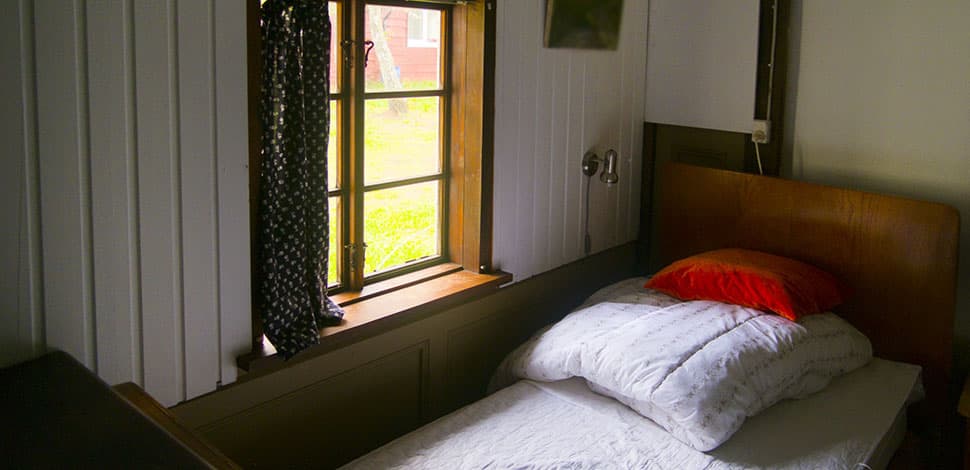 When analyzing the history of Guesthouse in Japan, it turns out that in the past, it was called the “Cheap Accommodation.” During the Edo period, a cheap inn called “Kichinyado” in the post town on the highway allowed people to stay for a night with the cost of wood (wood rent/cost) if they brought food such as rice to the inn. When the Meiji Restoration happened, and as new urban areas started to form, the cheap hotels moved to the poor street of the urban areas and increased in number as facilities named “Doya” used by day laborers and seasonal workers. A town with a lot of cheap hotels “Doya” was called the “Doya town,” and even nowadays, people can still find some traces of the “Doya” in places such as Tokyo and others. After the rapid economic growth and the increase of financially stable people, “Doya” changed to the form of “Youth Hostels” used by students for cheap travel. In the ’70s, many students traveled domestically and overseas using these “Youth Hostels.” After the transition from “Doya” to “Youth Hostels,” the so-called “Guesthouse” images began to be formed in the 1990s. Japan, being one of the most advanced countries in the world, had the increase in demand for international tourism and changed the cheap accommodation to accommodation that is cheap and targets mid to long-term visitors such as backpackers. Nowadays, the Guesthouse has become a widely known accommodation style, and the users have not been limited by overseas travelers only but also domestic travelers, and the number of domestic travelers has been increasing as well. It is especially popular among travelers who seek to communicate with people.
When analyzing the history of Guesthouse in Japan, it turns out that in the past, it was called the “Cheap Accommodation.” During the Edo period, a cheap inn called “Kichinyado” in the post town on the highway allowed people to stay for a night with the cost of wood (wood rent/cost) if they brought food such as rice to the inn. When the Meiji Restoration happened, and as new urban areas started to form, the cheap hotels moved to the poor street of the urban areas and increased in number as facilities named “Doya” used by day laborers and seasonal workers. A town with a lot of cheap hotels “Doya” was called the “Doya town,” and even nowadays, people can still find some traces of the “Doya” in places such as Tokyo and others. After the rapid economic growth and the increase of financially stable people, “Doya” changed to the form of “Youth Hostels” used by students for cheap travel. In the ’70s, many students traveled domestically and overseas using these “Youth Hostels.” After the transition from “Doya” to “Youth Hostels,” the so-called “Guesthouse” images began to be formed in the 1990s. Japan, being one of the most advanced countries in the world, had the increase in demand for international tourism and changed the cheap accommodation to accommodation that is cheap and targets mid to long-term visitors such as backpackers. Nowadays, the Guesthouse has become a widely known accommodation style, and the users have not been limited by overseas travelers only but also domestic travelers, and the number of domestic travelers has been increasing as well. It is especially popular among travelers who seek to communicate with people.
What kind of people are staying at a Guesthouse?
 The most significant number of guests staying in the Guesthouses are foreign tourists who travel within Japan for weeks to a month. They enjoy traveling around tourist attractions and communicating with the locals while staying at the Guesthouses in various places in Japan. Some of them chose to stay at a Guesthouse to lower their accommodation cost due to their willingness to lengthen their stay and visit more places. And some others stay because of the desire to interact and communicate with the guests who use the Guesthouse. The guests of the Guesthouse are usually young adults between the age of 20s to early 30s. Other than foreign visitors, there are also Japanese users. The number of users increased not only for backpackers in Japan but also for students coming from rural areas for job hunting and those who want to interact with foreign tourists. The "Guesthouse" accommodation is accepted by people who are looking for a different kind of enjoyment compared to those who stay at a hotel or traditional Japanese inn when traveling.
The most significant number of guests staying in the Guesthouses are foreign tourists who travel within Japan for weeks to a month. They enjoy traveling around tourist attractions and communicating with the locals while staying at the Guesthouses in various places in Japan. Some of them chose to stay at a Guesthouse to lower their accommodation cost due to their willingness to lengthen their stay and visit more places. And some others stay because of the desire to interact and communicate with the guests who use the Guesthouse. The guests of the Guesthouse are usually young adults between the age of 20s to early 30s. Other than foreign visitors, there are also Japanese users. The number of users increased not only for backpackers in Japan but also for students coming from rural areas for job hunting and those who want to interact with foreign tourists. The "Guesthouse" accommodation is accepted by people who are looking for a different kind of enjoyment compared to those who stay at a hotel or traditional Japanese inn when traveling.
New Arrivals & Campaign Properties
Click here to see the new arrivals and campaign properties!
SHAREHOUSE
OAKHOUSE CHOFU
【Available from 2026/01/10】From Tsutsujigaoka Station、only about 20 mi……
Tokyo-to Chofu-shi Nishi Tsutsujigaoka
Keio line / Tsutsujigaoka(Tokyo) 14minutes
Move in conditions:
Female Male
- No Key Money
- No security deposit
- No Guarantor Deposit
- No brokerage Fee
- No guarantor
- No guarantor company
- Foreign Residents Allowed
- Furnished
- Monthly
Bicycle parking
Rooms for 2 or more available
¥52,000 - ¥68,000 Vacancy
SOCIAL RESIDENCE
GRAN MINAMI GYOTOKU
Open on December 6、 2024! Conveniently located a 10-minute walk from M……
Chiba-ken Ichikawa-shi Fukuei
TokyoMetro-Tozai line / Minami Gyotoku 9minutes
Move in conditions:
Female Male
- No Key Money
- No security deposit
- No Guarantor Deposit
- No brokerage Fee
- No guarantor
- No guarantor company
- Foreign Residents Allowed
- Furnished
- Monthly
Smoking area
Property with gym
Coworking space
Powder room
Garden, rooftop, terrace
Rooms for 2 or more available
¥63,000 - ¥67,000 Vacancy
¥20000 Off Initial Contract Fee!
-
Gender:
FemaleMale
-
Nationality:
Foreigner Japanese
-
Age:
10~29 30~49 Over 50
SOCIAL RESIDENCE
SOCIAL RESIDENCE ACADEMIA OSAKA AMAGASAKI
This is one of the largest share houses in Kansai with 110 rooms! Muko……
Hyogo-ken Amagasaki-shi Oshonishi-machi
Hanshin line / Amagasaki Centerpoolmae 6minutes
Move in conditions:
Female Male
- No Key Money
- No security deposit
- No Guarantor Deposit
- No brokerage Fee
- No guarantor
- No guarantor company
- Foreign Residents Allowed
- Furnished
- Monthly
Bicycle parking
Theater
Soundproof room
Smoking area
Library
Coworking space
Delivery box
Garden, rooftop, terrace
Rooms for 2 or more available
¥48,000 - ¥63,000 Vacancy
Limited Time Offer 40000 Yen off the contract fee From December 1 to January 31
-
Gender:
FemaleMale
-
Nationality:
Foreigner Japanese
-
Age:
10~29 30~49 Over 50
Recently viewed properties
-
![]()
APART & SHAREHOUSE
UENO RYOTEI FUKUI
JR-KeihinTohoku line / Uguisudani 10minutes
Move in conditions: Female Male Foreigner¥55,000 - ¥150,000
-
![]()
SHAREHOUSE
TACHIKAWA RETRO HOUSE
JR-Chuo line / Tachikawa 4minutes
Move in conditions: Female Male Foreigner¥44,000 - ¥57,000
-
![]()
SHAREHOUSE
MIYAMAEDAIRA TERRACE
Tokyu-Denentoshi line / Miyamaedaira 7minutes
Move in conditions: Female Male Foreigner¥65,000 - ¥71,000
-
![]()
SHAREHOUSE
PREMIERE MACHIYA
TokyoMetro-Chiyoda line / Machiya 5minutes
Move in conditions: Female Male Foreigner¥65,000 - ¥70,000
-
![]()
GRAN KOBE
Hanshin line / Uozaki 4minutes
Move in conditions: Female Male Foreigner¥51,000 - ¥55,000
